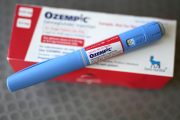A new report from the federal Centers for Disease Control and Prevention (CDC) National Center for Health Statistics shows that over a 10-year period, the use of antidepressants has skyrocketed across the United States by a staggering 400 percent — as the numbers of those diagnosed with Major Depressive Disorder (the clinical name for depression) and anxiety disorders has dramatically increased.
With the development of Prozac and similar drugs, more than one out of every 10 Americans over the age of 12 now takes an antidepressant, according to the findings. Researchers analyzed data collected from 12,637 people who participated in the center’s National Health and Nutrition Examination Surveys, which elicit information from about 5,000 Americans of all ages every year. Antidepressants were the third most common prescription drug taken by Americans of all ages in 2005–2008 and the most frequently used by persons aged 18–44 years. The nearly quadruple rate of antidepressant use was from 1988–1994 through 2005–2008.
Overall, women are more than twice as likely as men to take an antidepressant, the analysis reveals. The biggest users are women ages 40 to 59, with 23 percent of that group using an antidepressant. Among males and females ages 12 to 17, 3.7 percent take an antidepressant, compared with 6.1 percent of those ages 18 to 39, 15.9 percent of those 40 to 59, and 14.5 percent of those 60 and older.
Whites use antidepressants more commonly than anyone else, the surveys show. Fourteen percent of whites take an antidepressant, compared with 4 percent of blacks and 3 percent of Mexican-Americans. About 14 percent of Americans who take an antidepressant have been doing so for at least 10 years. More than 60 percent have been taking it for more than two years.
The CDC noted that about eight percent of Americans over age 12 with no current depression symptoms take the drugs for other reasons. And less than one-third of Americans taking one antidepressant and less than half of those taking multiple antidepressants had seen a “mental health professional” in the previous year. The surveys also discovered that there is no difference by income in the prevalence of antidepressant usage.
The CDC also found that overall, 40 percent of females and 20 percent of males with severe depressive symptoms take antidepressant medication. More than one-third of females with moderate depressive symptoms, and less than one-fifth of males with moderate depressive symptoms, take antidepressant medication; further, the use of antidepressant medication rises as severity of depressive symptoms increases among both males and females. More than 60 percent of Americans taking antidepressant medication have been using it longer than 2 years, and in general, there is no significant difference between males and females in length of use of antidepressants. Among persons taking antidepressants, approximately 14 percent take more than one; the percentage is similar for males and females, and among those taking multiple antidepressants, males are more likely than females to have seen a mental health professional in the past year.
An interesting fact on the nature of American mental health care revealed by the research is that often, it is non-psychiatrists who prescribe antidepressants on an alarming scale; lacking advanced training in mental health care, internists and family practitioners are limited to pharmacotherapy as the sole modality in treating depression and anxiety disorders. Norman Sussman, a professor of psychiatry at New York University’s Langone School of Medicine, in an interview with the Washington Post, said that it was a concern that many people are apparently having their antidepressants prescribed by doctors who were not psychiatrists. “It raises the use to a public health level. The fact that non-psychiatrists are not as well-informed about some of the risks and limitations of these drugs is of concern,” Sussman stressed.
Dr. Tolu Olupona, an assistant clinical professor of pediatrics and psychiatry at Mount Sinai Hospital Adolescent Health Center in New York City, observed: “It is surprising to learn that only about one-third of those taking one antidepressant have seen a mental health professional within the past year.”
Interestingly, the research also found that about eight percent of persons aged 12 and over with no current depressive symptoms takes antidepressant medication. This group may include persons who use antidepressants for reasons other than depression and persons taking antidepressants for depression who are being treated successfully and do not currently have depressive symptoms. Conversely, only slightly over one-third of persons aged 12 and over with current severe depressive symptoms is taking antidepressants. According to American Psychiatric Association guidelines, medications are the preferred treatment for moderate to severe depressive symptomatology; this under-treatment of severe depression represents a public health concern to many epidemiologists and mental health professionals.
Prozac Nation?
Many believe that the over-prescribing of antidepressants represents one of the longstanding problems with the delivery of mental health care in the United States. The U.S. faces a critical shortage of psychiatrists, clinical psychologists, and other mental health professionals, and psychiatry itself has largely turned away from employing non-pharmacological treatment modalities, such as Cognitive Behavioral Therapy (CBT), in the treatment of depression and other mental illnesses, due to disparities in insurance reimbursement (insurance companies typically cover 15-minute medication management sessions, but are not likely to cover psychotherapy on a prolonged basis. In addition, many psychiatrists no longer provide psychotherapy services because an hour-long psychotherapy session reimburses the same as 15 minutes of medication management, creating economic disincentive for providing non-pharmacological treatments).
The shortage of psychiatrists has largely resulted in the overuse of antidepressants. Sussman’s observations are empirically corroborated by a study published in the August issue of Health Affairs, which found that over a 12-year period, the percentage of visits in which antidepressants were prescribed to patients by doctors who didn’t record a specific psychiatric disorder increased from 59.5 percent of all visits in which non-psychiatrist physicians prescribed antidepressants in 1996 to 72.7 percent in 2007. Although antidepressants are clinically effective for major depressive disorder, chronic depression, and some anxiety disorders, researchers say the growing use of antidepressants by non-psychiatrists for a broader range of conditions raises worrisome questions about whether they are being inappropriately prescribed. Physicians are offering antidepressants to patients for use in boosting their moods, relieving mild anxiety, or improving sleep.
The proportion of antidepressants prescribed for patients without a psychiatric diagnosis increased from 2.5 percent of all visits to non-psychiatrist providers in 1996 to 6.4 percent in 2007. For visits to primary care providers, antidepressant prescribing for non-psychiatric disorders grew from 3.1 percent to 7.1 percent. For other non-psychiatric providers, visits without a psychiatric diagnosis grew from 1.9 percent to 5.8 percent. In contrast, antidepressants prescribed with a psychiatric diagnosis increased only slightly over that period, from 1.7 percent to 2.4 percent.
Regardless, several other factors may have contributed to the increased use of antidepressant medications. Perhaps most important, major depression may have become more common. Also, several antidepressants have now been approved by the FDA to treat depressive and anxiety disorders. Furthermore, other factors include the improving public attitudes toward seeking mental health in general, the increasing rates of treatment in individuals with major depression, and the growing public acceptance of a biological cause of depression.
Some analysts note, however, that the possible neurochemical attributes of depression are being emphasized to the detriment of addressing the broader psychosocial aspects of depression, resulting in treatment that fails to address all aspects of the disease.




